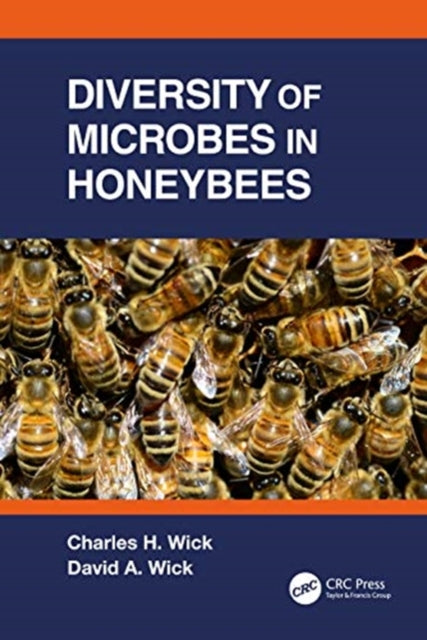Charles H. Wick,David A. Wick
Microbial Diversity in Honeybees
Microbial Diversity in Honeybees
YOU SAVE £6.24
- Condition: Brand new
- UK Delivery times: Usually arrives within 2 - 3 working days
- UK Shipping: Fee starts at £2.39. Subject to product weight & dimension
Bulk ordering. Want 15 or more copies? Get a personalised quote and bigger discounts. Learn more about bulk orders.
Couldn't load pickup availability
- More about Microbial Diversity in Honeybees
Honeybees are essential for our food chain, and their microbiome has declined, leading to this book's description and identification of the bee microbiome using proteomics technology. It contains new data and illustrates the rich diversity of microbes collected by honeybees.
Format: Hardback
Length: 248 pages
Publication date: 21 May 2021
Publisher: Taylor & Francis Ltd
Honeybees are a vital component of our food chain, serving as the primary pollinators for a wide range of food crops. Unfortunately, in recent years, honeybee populations have experienced a significant decline, which is believed to be linked to changes in their microbiome. This book aims to shed light on the bee microbiome and provide a comprehensive understanding of the diverse microorganisms found in honeybees.
Chapter 1: Introduction
Honeybees are essential pollinators for many crops, including fruits, vegetables, and nuts. However, their populations have been declining rapidly in recent years, leading to concerns about the future of our food supply. The decline in honeybee populations is believed to be linked to a variety of factors, including habitat loss, pesticide use, and disease.
Chapter 2: The Bee Microbiome
The bee microbiome is a complex ecosystem that consists of a wide range of microorganisms, including bacteria, fungi, and viruses. These microorganisms play important roles in the health and well-being of honeybees, including digestion, immunity, and communication.
Chapter 3: Detection and Identification of Microbes in Honeybees
To better understand the bee microbiome, researchers have used a variety of techniques, including DNA sequencing and proteomics. In this chapter, we will explore the methods used to detect and identify microbes found in honeybees collected around the United States.
Chapter 4: Microbial Diversity in Honeybees
Honeybees collect a wide range of microorganisms during their foraging activities, including bacteria, fungi, and viruses. This chapter will illustrate the rich diversity of microbes as collected by honeybees and highlight the important roles that these microorganisms play in the bee microbiome.
Chapter 5: Implications for the Honeybee Industry
The decline in honeybee populations has significant implications for the honeybee industry, which is worth billions of dollars worldwide. Understanding the bee microbiome can help researchers develop new strategies to protect and promote honeybee health.
Chapter 6: Conclusion
In conclusion, honeybees are a vital component of our food chain, and their health is critical to the sustainability of our planet. This book provides a comprehensive understanding of the bee microbiome and its implications for the honeybee industry and beyond.
Honeybees are a vital component of our food chain, serving as the primary pollinators for a wide range of food crops. Unfortunately, in recent years, honeybee populations have experienced a significant decline, which is believed to be linked to changes in their microbiome. This book aims to shed light on the bee microbiome and provide a comprehensive understanding of the diverse microorganisms found in honeybees.
Chapter 1: Introduction
Honeybees are essential pollinators for many crops, including fruits, vegetables, and nuts. However, their populations have been declining rapidly in recent years, leading to concerns about the future of our food supply. The decline in honeybee populations is believed to be linked to a variety of factors, including habitat loss, pesticide use, and disease.
Chapter 2: The Bee Microbiome
The bee microbiome is a complex ecosystem that consists of a wide range of microorganisms, including bacteria, fungi, and viruses. These microorganisms play important roles in the health and well-being of honeybees, including digestion, immunity, and communication.
Chapter 3: Detection and Identification of Microbes in Honeybees
To better understand the bee microbiome, researchers have used a variety of techniques, including DNA sequencing and proteomics. In this chapter, we will explore the methods used to detect and identify microbes found in honeybees collected around the United States.
Chapter 4: Microbial Diversity in Honeybees
Honeybees collect a wide range of microorganisms during their foraging activities, including bacteria, fungi, and viruses. This chapter will illustrate the rich diversity of microbes as collected by honeybees and highlight the important roles that these microorganisms play in the bee microbiome.
Chapter 5: Implications for the Honeybee Industry
The decline in honeybee populations has significant implications for the honeybee industry, which is worth billions of dollars worldwide. Understanding the bee microbiome can help researchers develop new strategies to protect and promote honeybee health.
Chapter 6: Conclusion
In conclusion, honeybees are a vital component of our food chain, and their health is critical to the sustainability of our planet. This book provides a comprehensive understanding of the bee microbiome and its implications for the honeybee industry and beyond.
Weight: 558g
Dimension: 172 x 235 x 21 (mm)
ISBN-13: 9780367539382
This item can be found in:
UK and International shipping information
UK and International shipping information
UK Delivery and returns information:
- Delivery within 2 - 3 days when ordering in the UK.
- Shipping fee for UK customers from £2.39. Fully tracked shipping service available.
- Returns policy: Return within 30 days of receipt for full refund.
International deliveries:
Shulph Ink now ships to Australia, Belgium, Canada, France, Germany, Ireland, Italy, India, Luxembourg Saudi Arabia, Singapore, Spain, Netherlands, New Zealand, United Arab Emirates, United States of America.
- Delivery times: within 5 - 10 days for international orders.
- Shipping fee: charges vary for overseas orders. Only tracked services are available for most international orders. Some countries have untracked shipping options.
- Customs charges: If ordering to addresses outside the United Kingdom, you may or may not incur additional customs and duties fees during local delivery.


